- SIEM Guide:
- Overview
- Get up and running
- SIEM UI
- Anomaly Detection with Machine Learning
- Detections (beta)
- Managing signal detection rules
- Prebuilt rule reference
- Adding Hidden File Attribute via Attrib
- Adobe Hijack Persistence
- Adversary Behavior - Detected - Elastic Endpoint
- Anomalous Process For a Linux Population
- Anomalous Process For a Windows Population
- Anomalous Windows Process Creation
- Attempt to Disable IPTables or Firewall
- Attempt to Disable Syslog Service
- Base16 or Base32 Encoding/Decoding Activity
- Base64 Encoding/Decoding Activity
- Bypass UAC via Event Viewer
- Clearing Windows Event Logs
- Command Prompt Network Connection
- Connection to External Network via Telnet
- Connection to Internal Network via Telnet
- Credential Dumping - Detected - Elastic Endpoint
- Credential Dumping - Prevented - Elastic Endpoint
- Credential Manipulation - Detected - Elastic Endpoint
- Credential Manipulation - Prevented - Elastic Endpoint
- DNS Activity to the Internet
- DNS Tunneling
- Delete Volume USN Journal with Fsutil
- Deleting Backup Catalogs with Wbadmin
- Direct Outbound SMB Connection
- Disable Windows Firewall Rules via Netsh
- Encoding or Decoding Files via CertUtil
- Enumeration of Kernel Modules
- Execution via Regsvcs/Regasm
- Exploit - Detected - Elastic Endpoint
- Exploit - Prevented - Elastic Endpoint
- FTP (File Transfer Protocol) Activity to the Internet
- File Deletion via Shred
- File Permission Modification in Writable Directory
- Hex Encoding/Decoding Activity
- Hping Process Activity
- IPSEC NAT Traversal Port Activity
- IRC (Internet Relay Chat) Protocol Activity to the Internet
- Interactive Terminal Spawned via Perl
- Interactive Terminal Spawned via Python
- Kernel Module Removal
- Local Scheduled Task Commands
- Local Service Commands
- Malware - Detected - Elastic Endpoint
- Malware - Prevented - Elastic Endpoint
- Microsoft Build Engine Loading Windows Credential Libraries
- Microsoft Build Engine Started an Unusual Process
- Microsoft Build Engine Started by a Script Process
- Microsoft Build Engine Started by a System Process
- Microsoft Build Engine Started by an Office Application
- Microsoft Build Engine Using an Alternate Name
- Mknod Process Activity
- Modification of Boot Configuration
- MsBuild Making Network Connections
- Net command via SYSTEM account
- Netcat Network Activity
- Network Connection via Certutil
- Network Connection via Compiled HTML File
- Network Connection via MsXsl
- Network Connection via Mshta
- Network Connection via Regsvr
- Network Connection via Signed Binary
- Network Sniffing via Tcpdump
- Nmap Process Activity
- Nping Process Activity
- PPTP (Point to Point Tunneling Protocol) Activity
- Permission Theft - Detected - Elastic Endpoint
- Permission Theft - Prevented - Elastic Endpoint
- Persistence via Kernel Module Modification
- Potential Application Shimming via Sdbinst
- Potential DNS Tunneling via Iodine
- Potential Disabling of SELinux
- Potential Evasion via Filter Manager
- Potential Modification of Accessibility Binaries
- Potential Shell via Web Server
- PowerShell spawning Cmd
- Process Activity via Compiled HTML File
- Process Discovery via Tasklist
- Process Injection - Detected - Elastic Endpoint
- Process Injection - Prevented - Elastic Endpoint
- Process Injection by the Microsoft Build Engine
- Proxy Port Activity to the Internet
- PsExec Network Connection
- RDP (Remote Desktop Protocol) from the Internet
- RDP (Remote Desktop Protocol) to the Internet
- RPC (Remote Procedure Call) from the Internet
- RPC (Remote Procedure Call) to the Internet
- Ransomware - Detected - Elastic Endpoint
- Ransomware - Prevented - Elastic Endpoint
- SMB (Windows File Sharing) Activity to the Internet
- SMTP on Port 26/TCP
- SMTP to the Internet
- SQL Traffic to the Internet
- SSH (Secure Shell) from the Internet
- SSH (Secure Shell) to the Internet
- Setgid Bit Set via chmod
- Setuid Bit Set via chmod
- Socat Process Activity
- Strace Process Activity
- Sudoers File Modification
- Suspicious MS Office Child Process
- Suspicious MS Outlook Child Process
- Suspicious PDF Reader Child Process
- Suspicious Powershell Script
- Svchost spawning Cmd
- System Shells via Services
- TCP Port 8000 Activity to the Internet
- Telnet Port Activity
- Tor Activity to the Internet
- Trusted Developer Application Usage
- Unusual DNS Activity
- Unusual Linux Network Activity
- Unusual Linux Network Port Activity
- Unusual Linux Network Service
- Unusual Linux Username
- Unusual Linux Web Activity
- Unusual Login Activity
- Unusual Network Connection via RunDLL32
- Unusual Network Destination Domain Name
- Unusual Parent-Child Relationship
- Unusual Process Execution - Temp
- Unusual Process For a Linux Host
- Unusual Process For a Windows Host
- Unusual Process Network Connection
- Unusual Web Request
- Unusual Web User Agent
- Unusual Windows Network Activity
- Unusual Windows Path Activity
- Unusual Windows Remote User
- Unusual Windows Service
- Unusual Windows User Privilege Elevation Activity
- Unusual Windows Username
- User Account Creation
- User Discovery via Whoami
- VNC (Virtual Network Computing) from the Internet
- VNC (Virtual Network Computing) to the Internet
- Virtual Machine Fingerprinting
- Volume Shadow Copy Deletion via VssAdmin
- Volume Shadow Copy Deletion via WMIC
- Web Application Suspicious Activity: No User Agent
- Web Application Suspicious Activity: POST Request Declined
- Web Application Suspicious Activity: Unauthorized Method
- Web Application Suspicious Activity: sqlmap User Agent
- Whoami Process Activity
- Windows CryptoAPI Spoofing Vulnerability (CVE-2020-0601 - CurveBall)
- Windows Script Executing PowerShell
- Tuning prebuilt detection rules
- Prebuilt rule changes per release
- Cases (beta)
- SIEM APIs
- Detections API
- Cases API
- Create case
- Add comment
- Update case
- Update comment
- Find cases
- Get case
- Get all case comments
- Get comment
- Get all case activity
- Get tags
- Get reporters
- Get status
- Delete comment
- Delete all comments
- Delete case
- Set default SIEM UI connector
- Update case configurations
- Get current connector
- Find connectors
- Add external details to case
- Actions API (for pushing cases to external systems)
- SIEM field reference guide
IMPORTANT: No additional bug fixes or documentation updates will be released for this version.
SIEM UI
editSIEM UI
editThe SIEM app is a highly interactive workspace designed for security analysts. It provides a clear overview of events from your environment, and you can use the interactive UI to drill down into areas of interest.
The Kibana Query Language (KQL) bar is available throughout the SIEM app for searching and filtering. You can also select areas of interest in time-based histograms, which updates the timepicker.

All SIEM histograms, graphs, and tables contain an Inspect button, so you can examine the Elasticsearch queries used to retrieve data throughout the app.
Chart legends and many grid fields are interactive. Fields that can be dragged to Timeline are indicated with two dotted vertical lines, and are highlighted when you hover over a grid’s row:
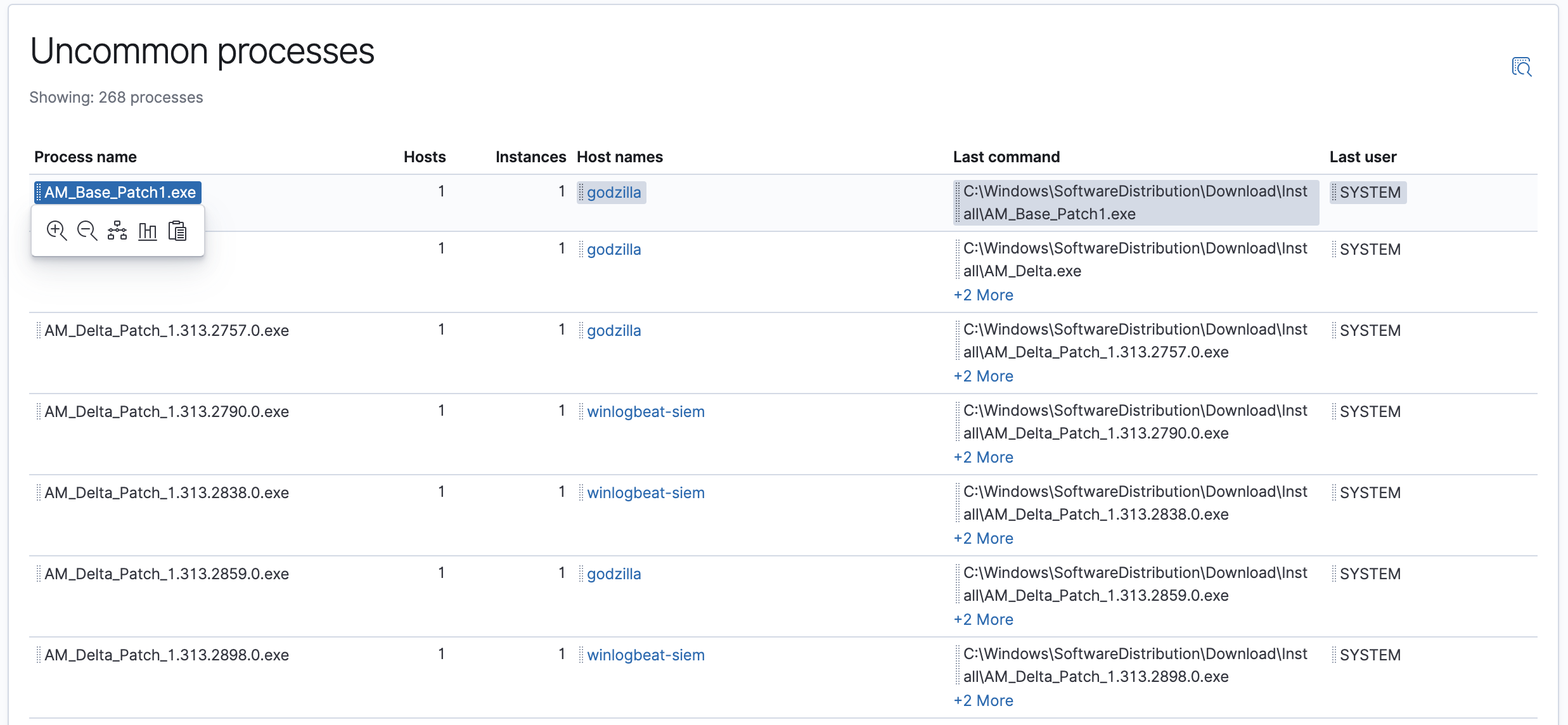
When a popup menu appears while hovering over a field, you can perform these actions:
- Filter for value: adds the field to the filter bar
-
Filter out value: adds the field with a
NOToperator to the filter bar - Add to Timeline investigation: adds the field to Timeline
- Show top <field name>: displays a histogram of the top field values
- Copy to clipboard: copies the field and its value to your clipboard, using KQL syntax
The default index glob patterns defined for SIEM events are
endgame-*, auditbeat-*, winlogbeat-*, filebeat-*, packetbeat-*,
and apm-*-transaction*. You can change the default glob patterns in Kibana →
Management → Advanced Settings → siem:defaultIndex.
Overview page
editThe Overview page provides a high-level view of security events available for analysis, and can help surface problems with data ingestion.
Search
editFilter for signals, events, process and other important security information with the benefit of Kibana Query Language (KQL) in the SIEM search bar. A date/time filter set to Last 24 hours is enabled by default, but can be changed to any time range. If you want to filter your search results with other fields, select Add Filter, followed by the field from which to filter and the operator (such is not or is between) for your query.
To save specific filters and queries, click the Save icon and then Save current query.
Timelines
editSelect the collapsable Timeline button on the right of the SIEM UI to start an investigation. See the Timelines section for more information.
The most recent timelines you’ve accessed appear in Recent Timelines.
Signals count
editThe signals histogram displays a count of all the Signals detected by the SIEM app within a set time frame. In the Stack by dropdown, select specific parameters for which to visualize the signal count. For example, stack by user.name for the graph to visualize the number of signals attributed to a specific user.
To create signal detection rules, see Managing Signal Detection Rules.
External alerts count
editThe external alerts histogram displays a count within a certain time frame. You can stack by two parameters: event-category or event.module.
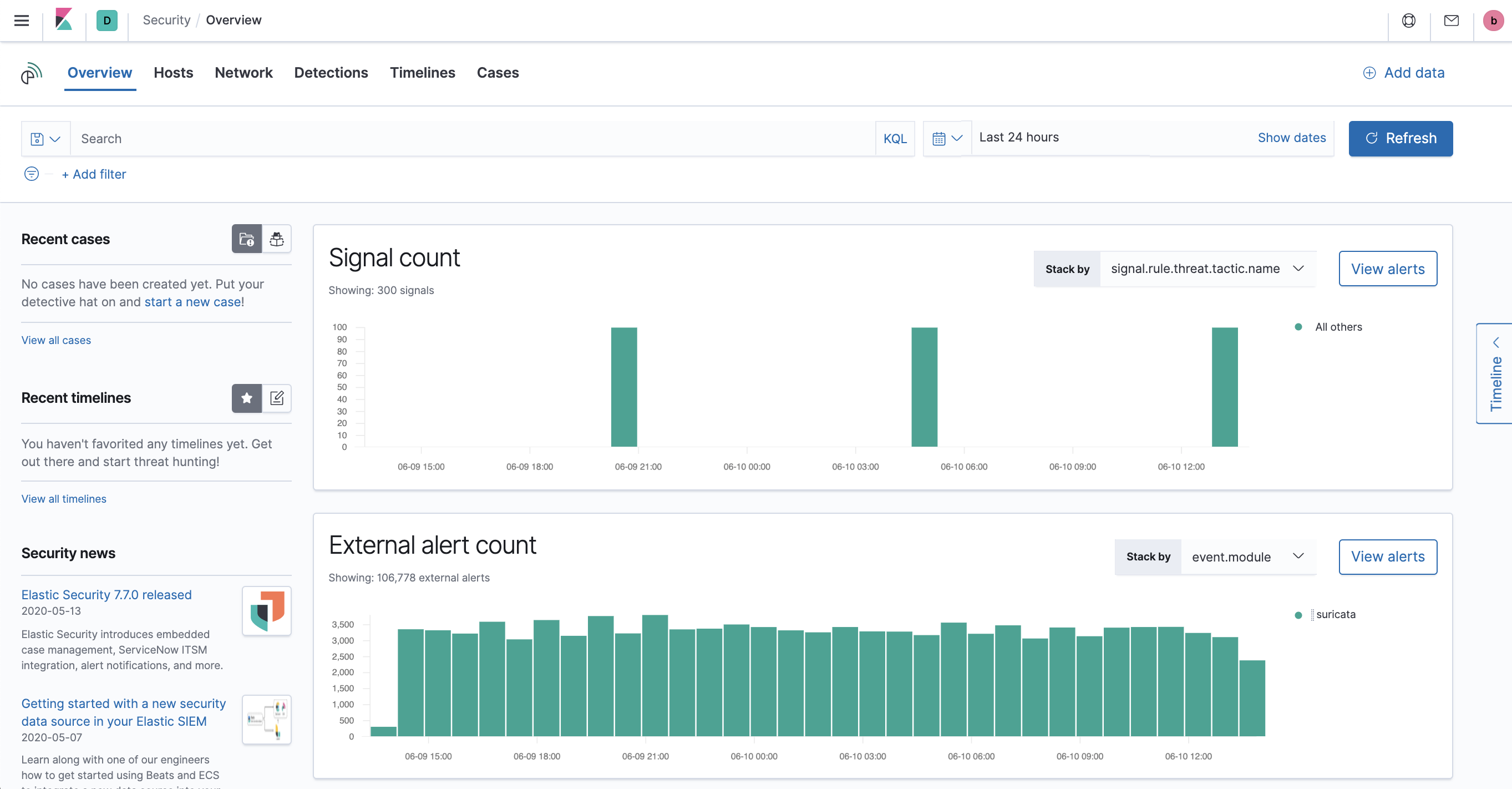
Events count
editThe events count histogram displays a count of all events within a set time frame. You can stack by event.action, event.dataset, or event.module.
Host and network events
editView event and host counts specific to Elastic data shippers and apps, such as Auditbeats or Elastic Endpoint Security. Expand each category for specific counts of hosts or network events related to the category.
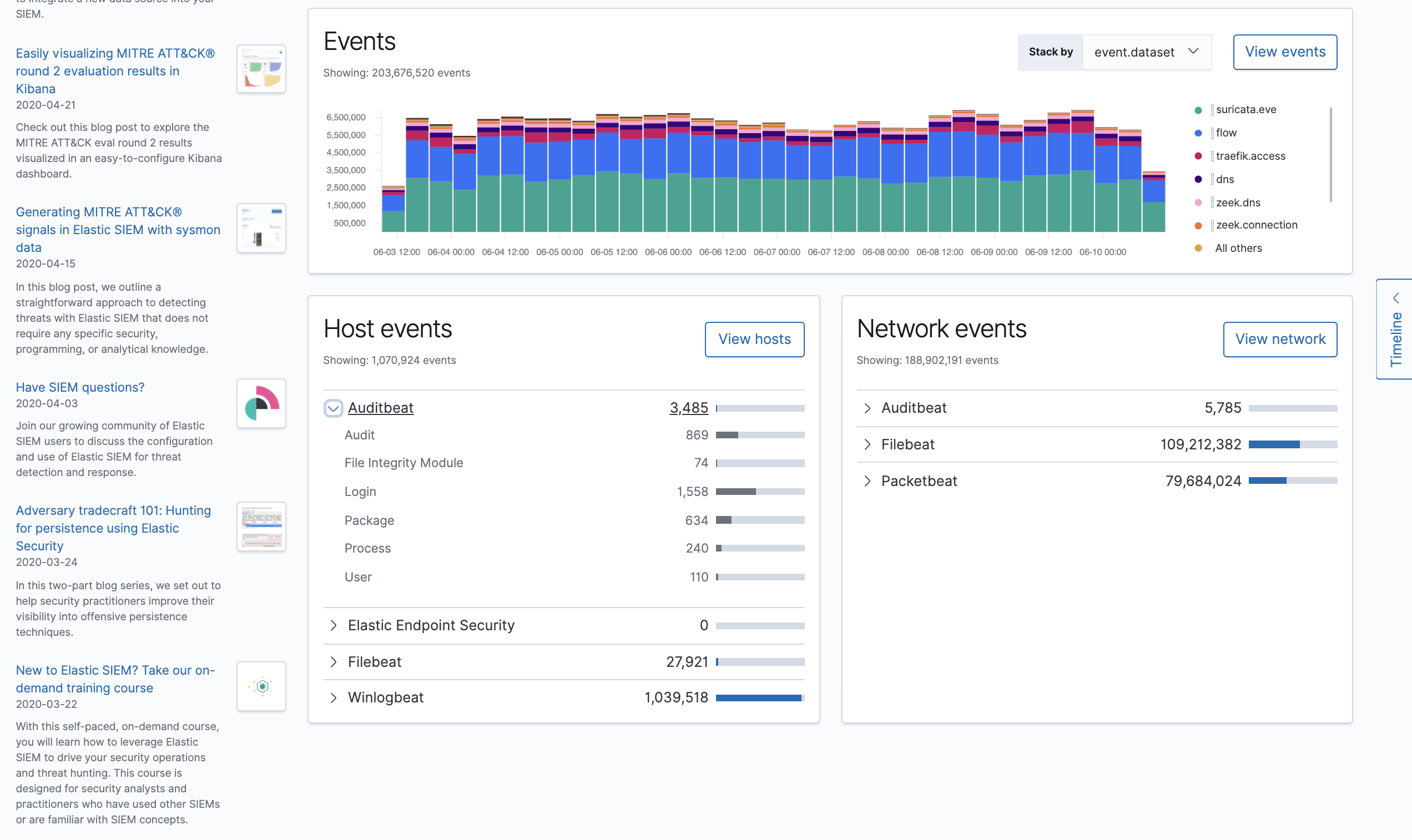
Hosts page
editThe Hosts view provides key metrics regarding host-related security events, and a set of data tables that let you interact with the Timeline Event Viewer. You can drag and drop items of interest from the Hosts view tables to Timeline for further investigation.
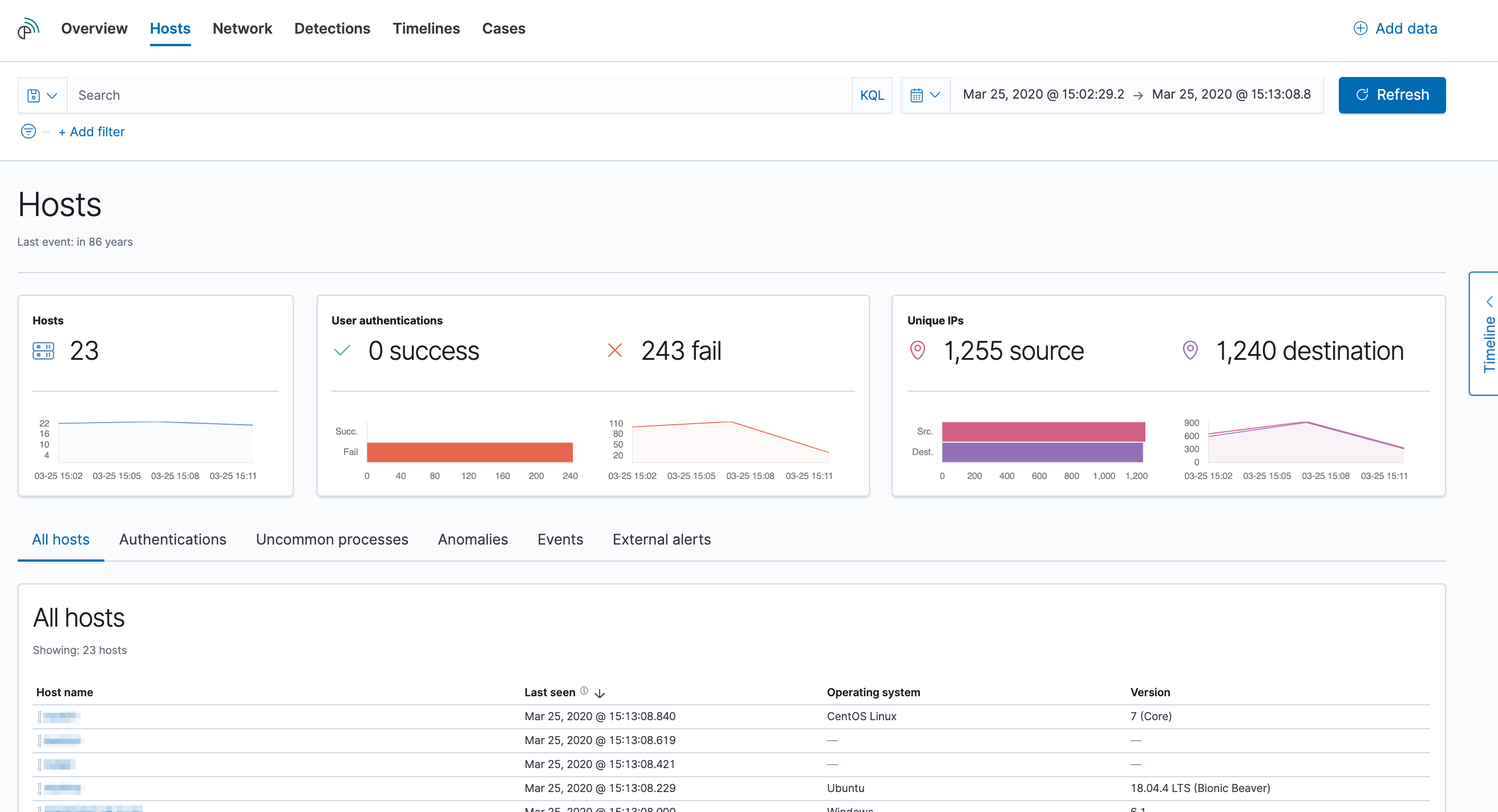
Interactive widgets let you drill down for deeper insights:
- Hosts
- User Authentications (success and failures)
- Unique IPs
There are also tabs for viewing and investigating specific types of data:
- All hosts: high-level host details
- Authentications: authentication events
- Uncommon processes: uncommon processes running on hosts
- Anomalies: anomalies discovered by machine learning jobs
- Events: all host events
- External alerts: alerts received from external monitoring tools, such as Elastic Endpoint Security
Host detail pages show information for a selected host, including Host ID, First Seen timestamp, Last Seen timestamp, IP and MAC addresses, OS, versions, machine type, and so forth. Additionally, it contains all the widgets and tabs relevant for the selected host.
Network page
editThe Network view provides key network activity metrics and an interactive map, and provides network event tables that enable interaction with the Timeline. You can drag and drop items of interest from the Network view to Timeline for further investigation.
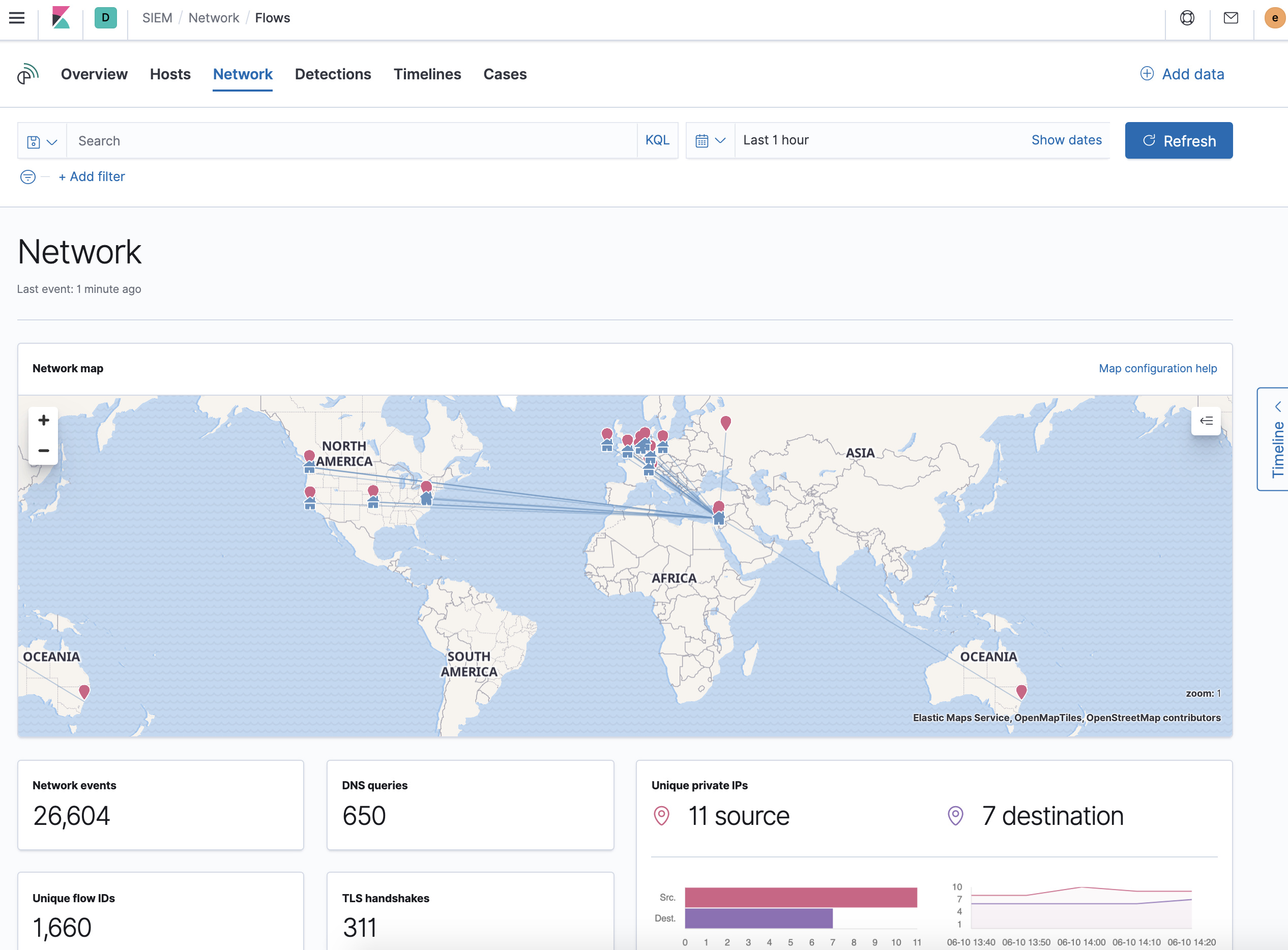
Interactive widgets let you drill down for deeper insights:
- Network events
- DNS queries
- Unique flow IDs
- TLS handshakes
- Unique private IPs
There are also tabs for viewing and investigating specific types of data:
- Flows: source and destination IP addresses and countries
- DNS: DNS network queries
- HTTP: received HTTP requests (HTTP requests for applications using Elastic APM are monitored by default)
- TLS: handshake details
- Anomalies: anomalies discovered by machine learning jobs
- External alerts: alerts received from external monitoring tools, such as Elastic Endpoint Security
IP detail pages show information for the selected IP address, including
links to external sites for verifying the IP address’s reputation. By default,
the external sites are TALOS and
VIRUSTOTAL. You can change the displayed
reputation links in Kibana → Management → Advanced Settings →
siem:ipReputationLinks. The siem:ipReputationLinks setting contains a
JSON array with these fields:
-
name: UI display name. -
url_template: URL of the link. It can include{{ip}}, which is placeholder for the IP address you are viewing on the details page.
For example:
[ { "name": "virustotal.com", "url_template": "https://www.virustotal.com/gui/search/{{ip}}" }, { "name": "dnschecker.org", "url_template": "https://www.dnschecker.org/ip-location.php?ip={{ip}}" }, { "name": "talosIntelligence.com", "url_template": "https://talosintelligence.com/reputation_center/lookup?search={{ip}}" } ]
Map
editThe map provides a visual overview of your network traffic. It is interactive, so you can start exploring data directly from the map. Hover over source and destination points to see more information, such as hostnames and IP addresses. To drill down, click a point and use the filter icon to add a field to the filter bar or drag a field to the Timeline. You can also click a hostname to jump to the SIEM Host page, or an IP address to open the relevant network details.
Just as you can start an investigation using the map, the map refreshes to show relevant data when you run a query or update the time frame.
To add and remove layers, click on the more options icon in the top right corner of the map.
Configuring map data describes how to add map data and set up interactions.
Detections page
editThe Detections page provides an overview of all the signals created by signal detection rules. It is also the place where you can enable prebuilt rules and create new rules. Detections (beta) provides a detailed description of Detections and how to use it.
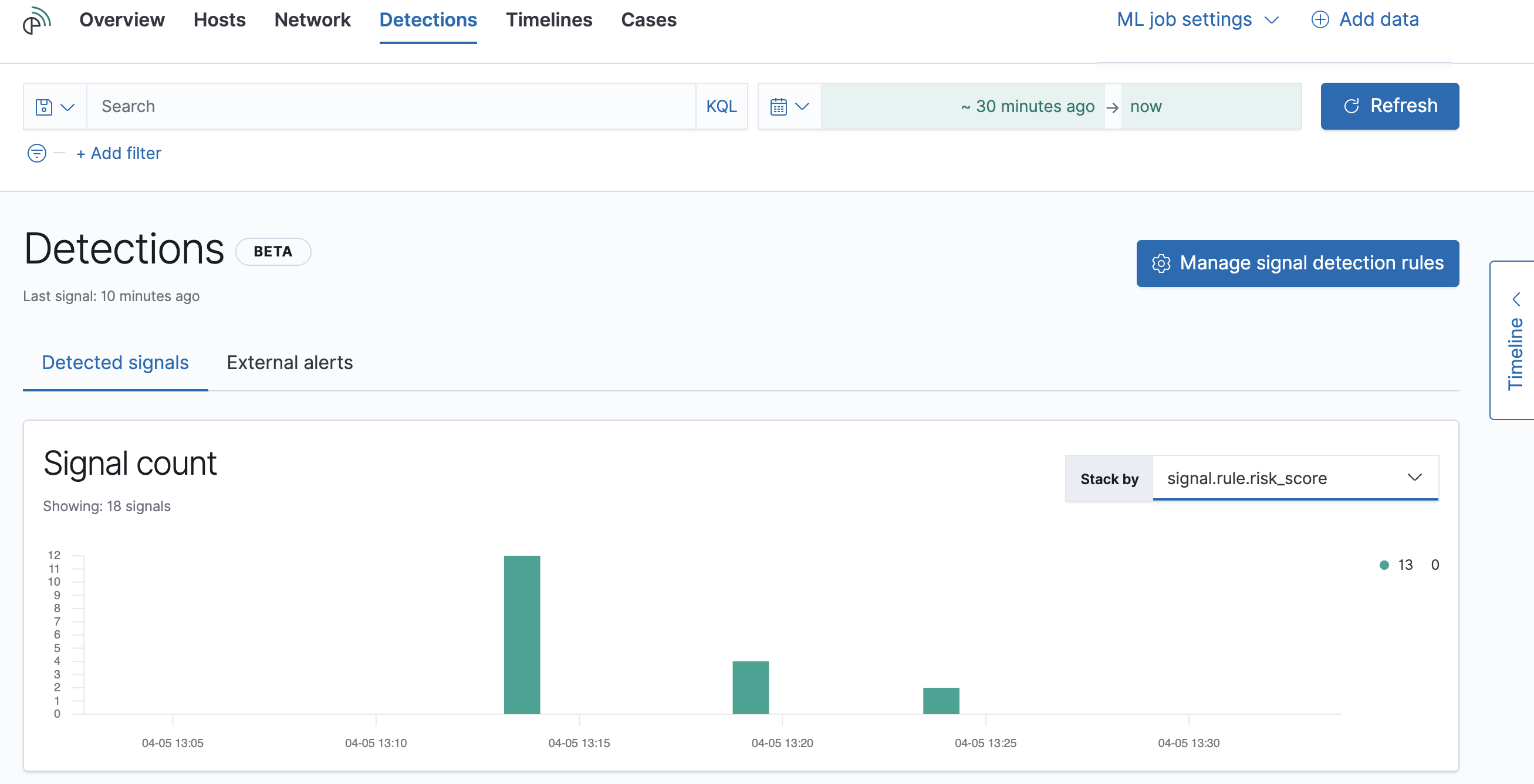
The Signal count histogram shows the detection rate of signals
according to various attributes, including Risk scores, Severities, and
Top event categories. The All signals table helps with investigations,
allowing you to search, filter, and aggregate all SIEM signals.
Cases page
editThe Cases page is used to open and track security issues directly in the SIEM app. For more information, see Cases (beta).
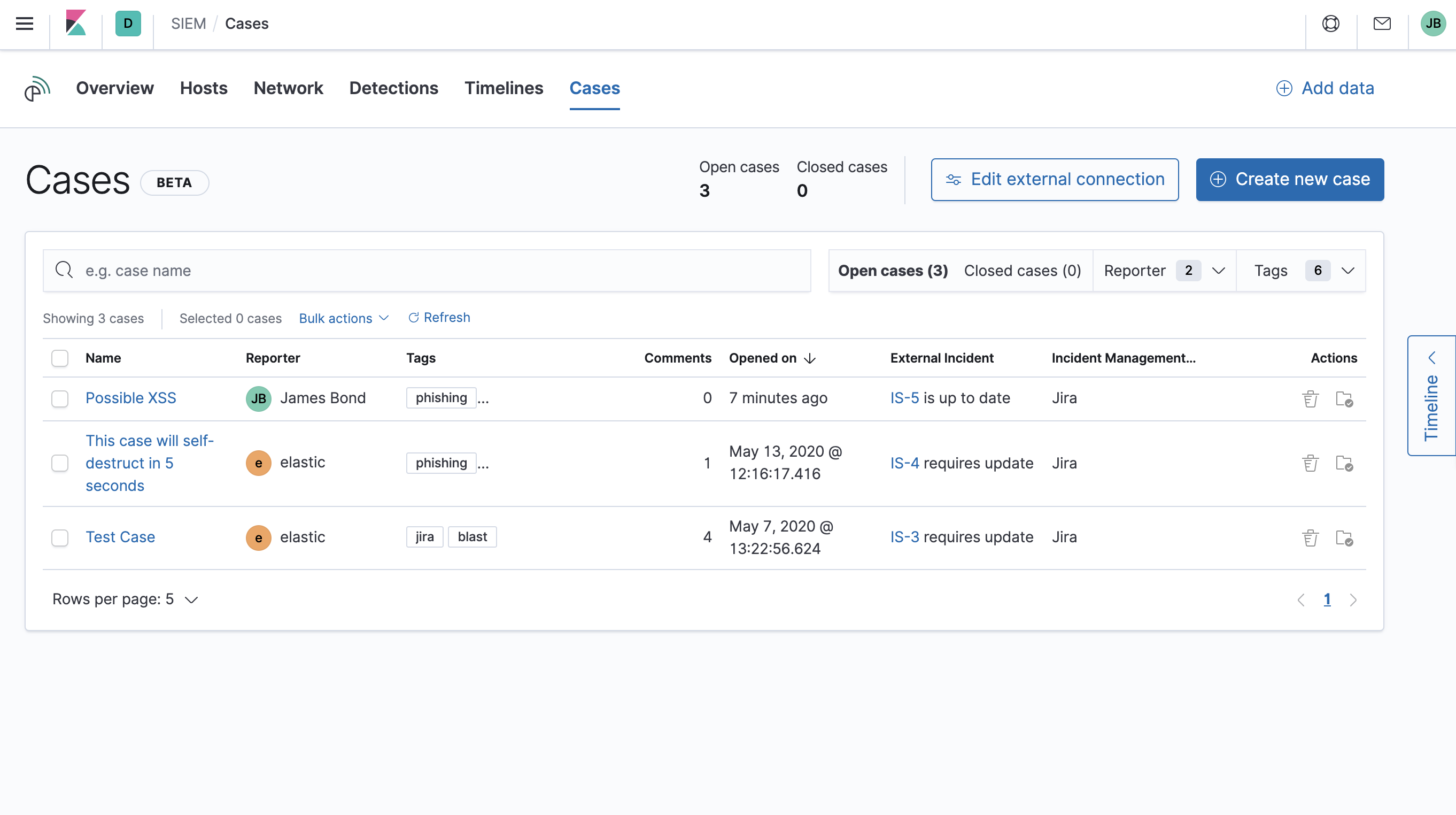
Timelines
editUse Timeline as your workspace for alert investigations or threat hunting. Data from multiple indices can be added to a timeline, which enables investigating complex threats, such as lateral movement of malware across hosts in your network.
You can drag objects of interest into Timeline to create exactly the query filter you need to get to the bottom of an alert. You can drag items from table widgets within Hosts and Network pages, or even from within Timeline itself.
A timeline is responsive and persists as you move through the SIEM app collecting data. Auto-saving ensures that the results of your investigation are available for review by other analysts and incident response teams.
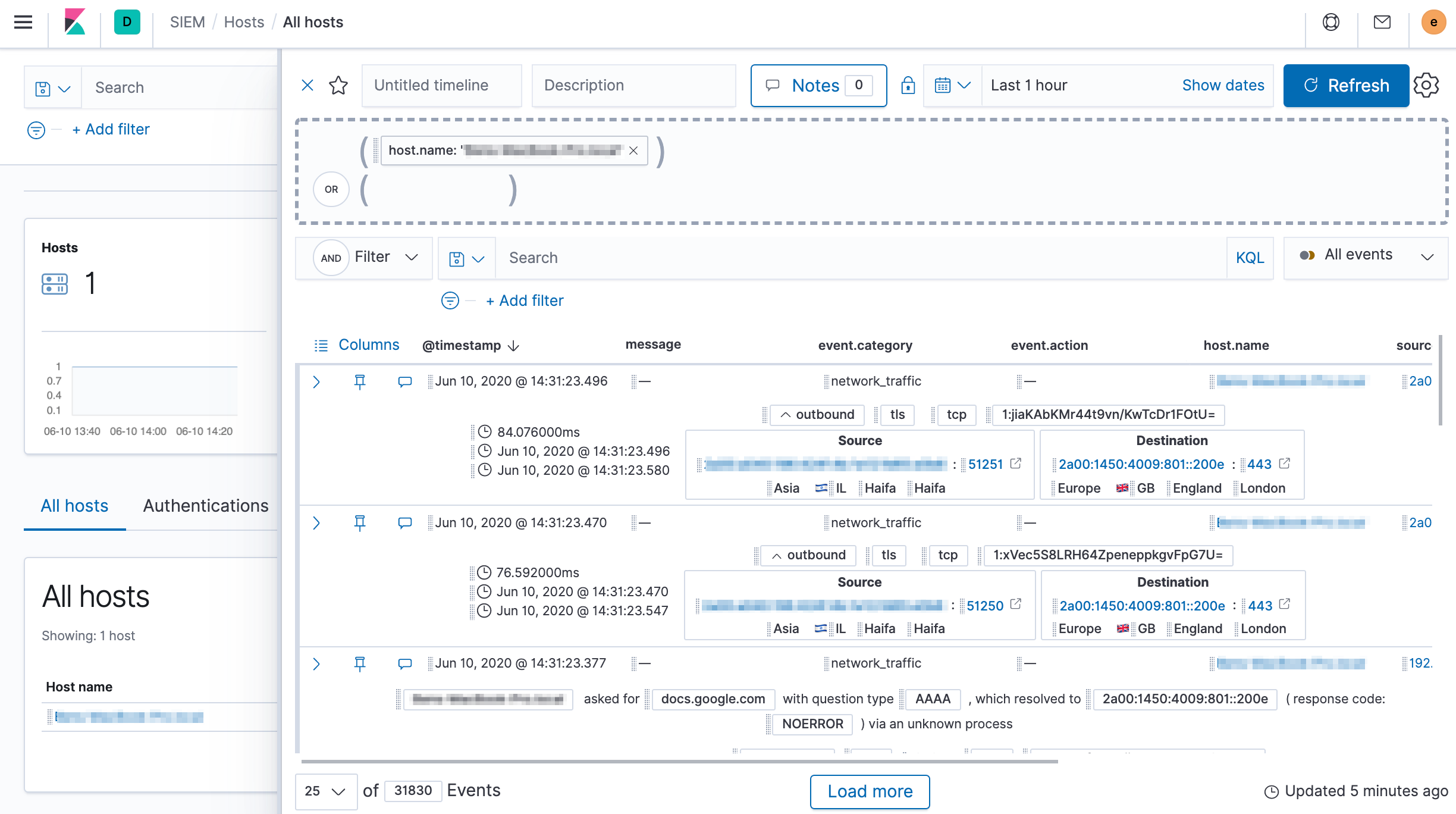
Add notes for your own use and to communicate your workflow and findings to others. You can share a timeline, or pass it off to another person or team. You can also link to timelines from Cases and external ticketing systems.
Focus on signals or raw events
editMany security events in Timeline are presented in an easy-to-follow rendered view, which enables quicker analyst understanding. Using the drop-down options by the KQL bar, you can select whether signals, other raw events, or both are displayed in the Timeline.
You can click and expand events from within Timeline to see the underlying event data, either in tabular form, or as Elasticsearch JSON.
Narrow or expand your query
editYou can specify logical AND and OR operations with an item’s placement in
the drop area. Horizontal filters are AND-ed together. Vertical filters or
sets are OR-ed together. As you hover the item over the drop area, you can see
whether your placement is on target to create an AND or OR filters.
Pivot on a data point
editClick a filter to access additional operations such as exclude, temporarily disable, or delete items from the query. For example, you can change an included item so that it is excluded.
Get more context for each event
editAs you build and modify your queries, you can see the results of your interactions in the details pane below.
As your query takes shape, an easy-to-follow rendered view appears for events. It shows relevant contextual information that helps tell the backstory of the event. If you see a particular item that interests you, you can drag it to the drop area for further introspection.
Export and import timelines
editYou can import and export timelines, which enables importing timelines from one
Kibana space or instance to another. Exported timelines are saved in an
ndjson file.
- Go to SIEM → Timelines.
-
To export timelines, do one of the following:
- To export one timeline, click the more actions icon in the relevant row and then select Export selected.
- To export multiple timelines, select all the required timelines and then click Bulk actions → Export selected.
-
To import timelines, click Import Timeline and then select or drap-and-drop
the timeline
ndjsonfile.
Other actions
editThe Timeline is flexible and highly interactive. As you would expect, the SIEM app lets you:
- add, remove, reorder, or resize Timeline columns
- save, open, and list Timelines
- add notes to individual events
- add investigation notes for the whole Timeline
- pin events to the Timeline for persistence
Try clicking to expand or collapse items, or dragging and dropping them to other areas to see what happens. Are there interactions that you would expect to see that aren’t present? Let us know. We welcome your input.
On this page
- Overview page
- Search
- Timelines
- Signals count
- External alerts count
- Events count
- Host and network events
- Hosts page
- Network page
- Map
- Detections page
- Cases page
- Timelines
- Focus on signals or raw events
- Narrow or expand your query
- Pivot on a data point
- Get more context for each event
- Export and import timelines
- Other actions